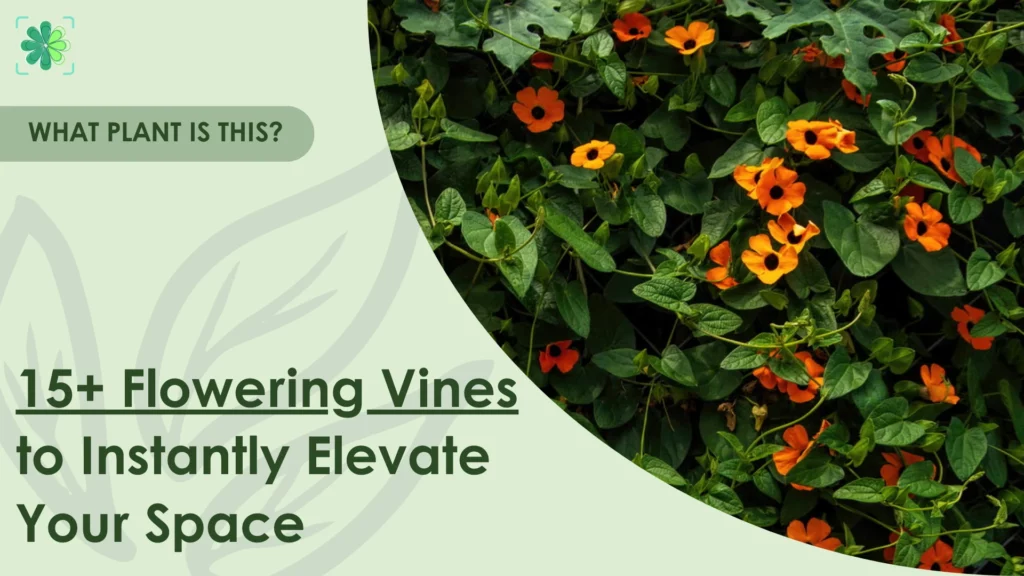
Flowering vines bring instant charm to any space, whether they’re climbing a fence, spilling over a balcony, or weaving through a garden trellis. With their mix of color, movement, and texture, these plants do more than decorate; they transform. In this guide, you’ll discover 15+ flowering vines that not only look beautiful but are also easy to grow. Whether you’re new to gardening or just want to freshen up your space, this list will help you find the perfect vine to suit your style.
Do Vines Have Flowers?
Many vines do have flowers, but not all. Some are grown for their colorful blooms, while others are valued for their leaves. Understanding the difference helps you choose the right vine for your space. Flowering vines belong to a group of vines flowering plants. These include popular garden climbers like:
- Clematis
- Morning glory
- Passionflower
- Wisteria
- Trumpet vine
In contrast, non-flowering vines (or rarely flowering ones) focus on foliage. These include:
- English ivy
- Pothos
- Heartleaf philodendron

Some vines may only flower in the right climate or when they’re fully mature. So if a vine isn’t blooming, it could still be healthy. It just might not be a flowering variety, or it may need more time or sunlight. In short, yes, many vines have flowers. But it depends on the species, conditions, and sometimes age. If you’re unsure, tools like Planteyes can help you quickly identify whether a vine is a blooming type.
Types of Flowering Vines
There are three main ways flowering vines grow:
Twining vines twist their stems around anything nearby: fences, poles, trellises. Morning glory and honeysuckle are good examples. They’re easy to train and great for vertical spaces.
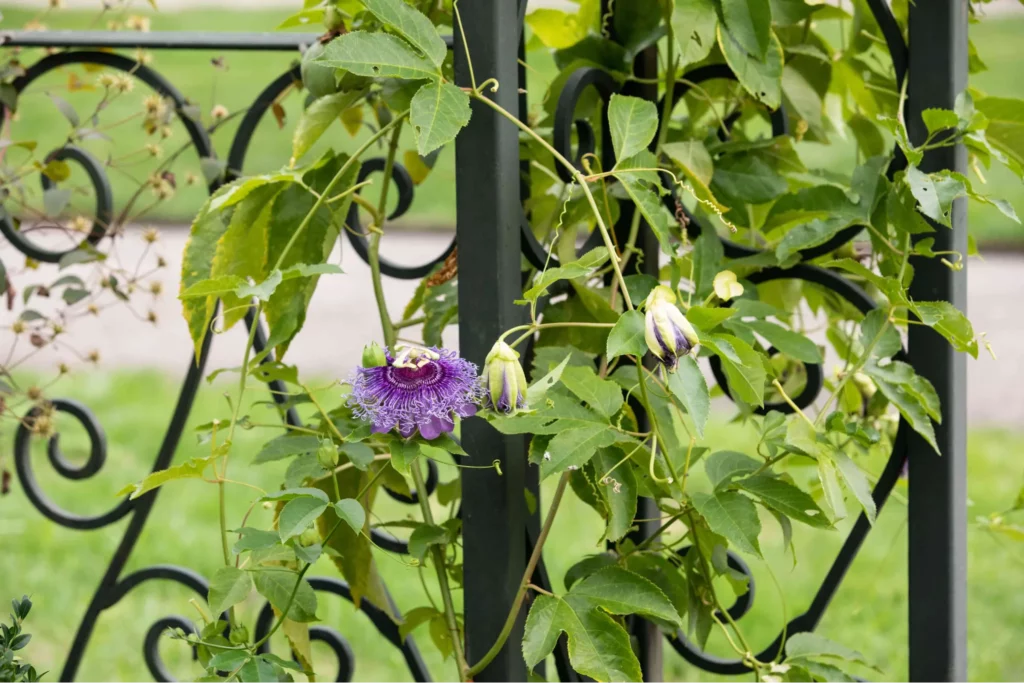
Tendril-bearing vines send out thin, curly tendrils to grab onto wires, strings, or neighboring plants. Passionflower and sweet pea use this method. These vines often need a structure with smaller gaps so the tendrils can grip firmly.
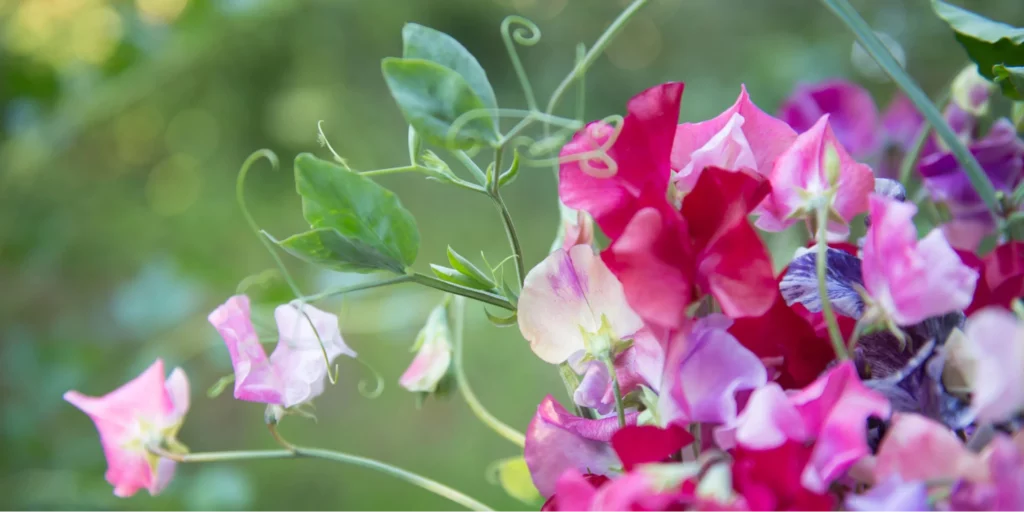
Clinging vines stick to surfaces with small rootlets or adhesive pads. Climbing hydrangea and trumpet vine fall into this group. They can climb straight up walls, trees, or bricks, sometimes without any extra support.
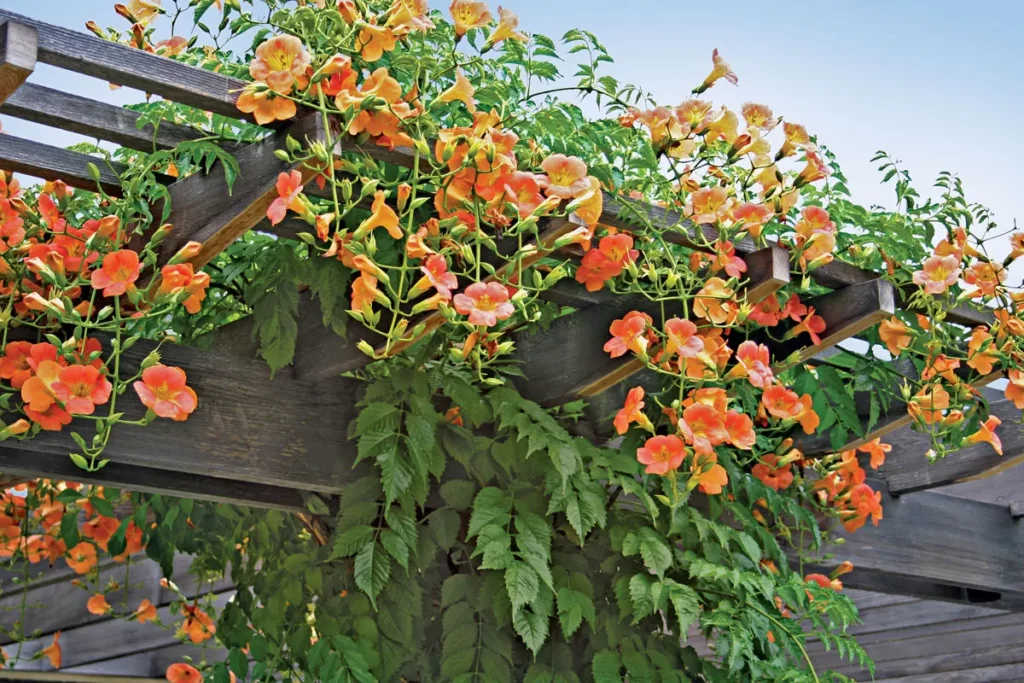
Some flowering vines are also woody, meaning they produce thick, strong stems that last for years. Wisteria and bougainvillea are two striking examples. Others are herbaceous, which means they stay soft and green, often dying back in winter and regrowing in spring. You can also think of flowering vines by climate. Tropical vines, such as mandevilla or coral vine, thrive in warm, sunny conditions. Temperate vines like clematis or star jasmine prefer cooler, seasonal weather.
15+ Flowering Vines to Know and Grow
Each flowering vine grows a little differently. Some need strong support, others prefer light trellises. Some bloom fast, others take time. Below are 15+ popular flowering vines, with basic information to help you identify or grow them with confidence.
Morning Glory
- Type: Annual
- Size: 6–10 feet
- Hardiness Zones: 2–11
- Growing Conditions: Full sun, average to poor soil, good drainage
- Bloom Season: Late spring to early fall
- Care Tip: Avoid overly rich soil. Too much nitrogen will lead to more leaves, fewer blooms
Interesting Note: Morning glory flowers open early in the day and close by afternoon, especially on hot or cloudy days. They’re also self-seeding, so once established, they often come back without replanting.
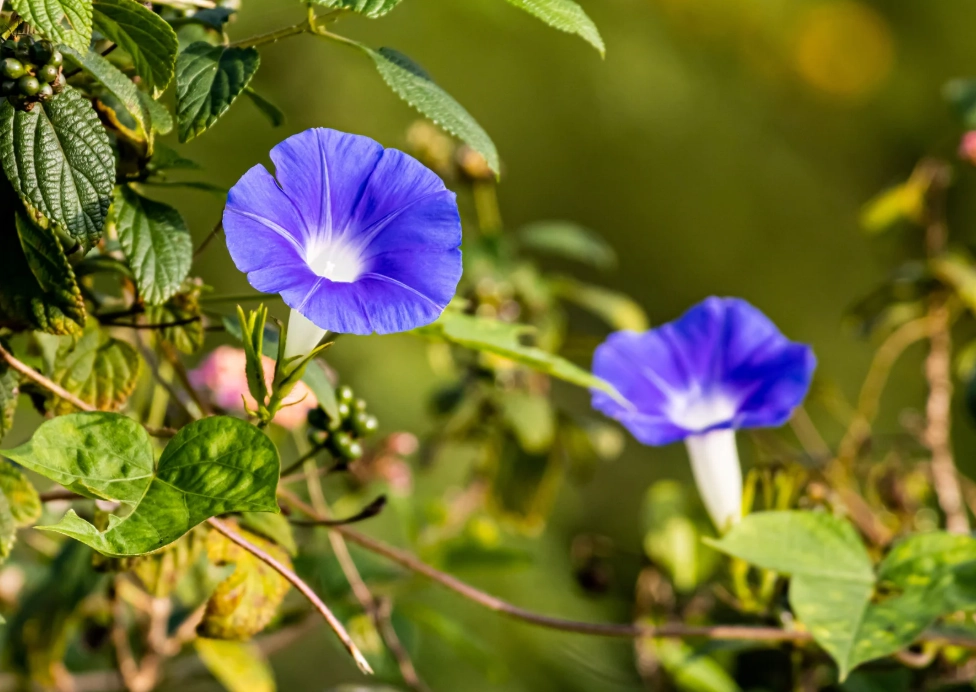
Clematis
- Type: Perennial
- Size: 8–20 feet
- Hardiness Zones: 4–9
- Growing Conditions: Full sun to part shade, rich moist soil, prefers cool roots
- Bloom Season: Depends on variety: some bloom in spring, others in summer or fall
- Care Tip: Mulch the base or grow low plants nearby to shade the roots and keep them cool
Interesting Note: Clematis comes in hundreds of varieties, with flowers ranging from small bell shapes to large, showy stars. You can pair early and late bloomers together for extended color on the same support.

Wisteria
- Type: Perennial
- Size: 15–30 feet or more
- Hardiness Zones: 5–9
- Growing Conditions: Full sun, fertile well-draining soil, needs strong support
- Bloom Season: Late spring to early summer
- Care Tip: Prune twice a year: once in summer and once in winter, to control size and boost blooming
Interesting Note: While Asian varieties (Chinese, Japanese) are more aggressive, American wisteria (Wisteria frutescens) is less invasive and blooms later, making it better suited for small gardens.
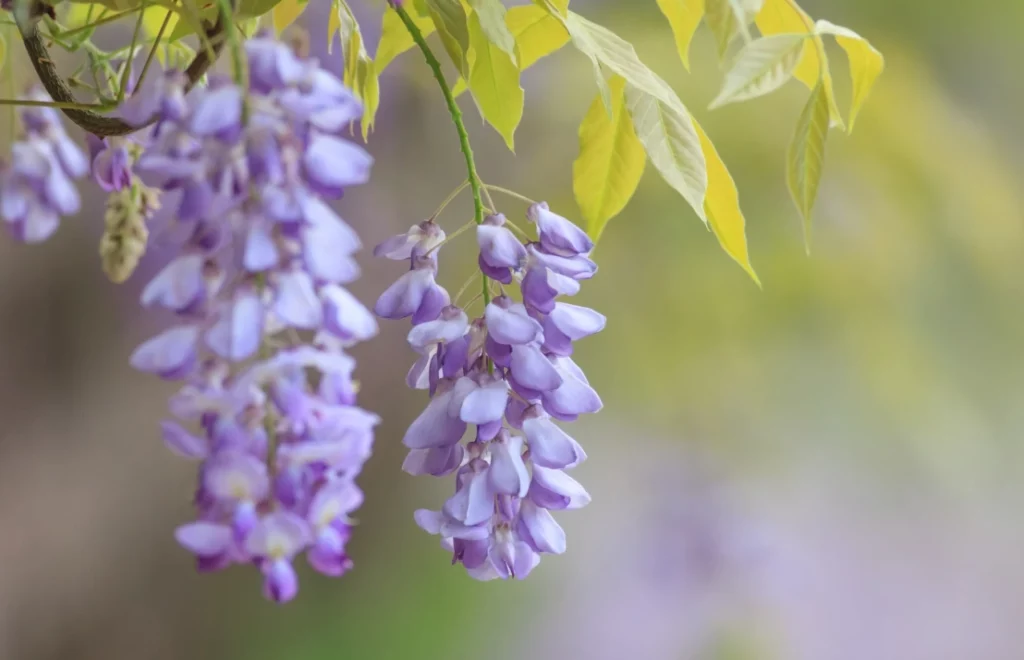
Trumpet Vine
- Type: Perennial
- Size: 20–30 feet
- Hardiness Zones: 4–9
- Growing Conditions: Full sun, average soil, drought-tolerant once established
- Bloom Season: Midsummer to early fall
- Care Tip: Cut back hard in late winter to keep it in check and encourage better flowering
Interesting Note: Trumpet vine attracts hummingbirds like a magnet, but it spreads aggressively through underground runners. Plant it away from foundations or delicate garden beds unless you plan to contain it.
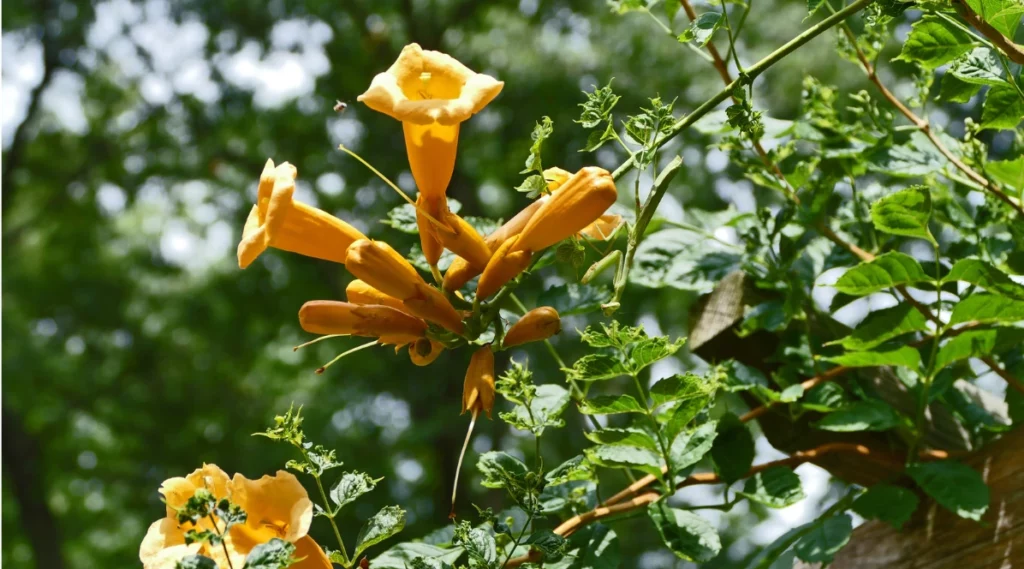
Sweet Pea
- Type: Annual (some perennial varieties exist)
- Size: 4–6 feet
- Hardiness Zones: 2–11 (as an annual)
- Growing Conditions: Full sun, rich well-draining soil, cool weather
- Bloom Season: Late spring to early summer (longer in cooler climates)
- Care Tip: Sow early in the season, keep the soil moist, and pick flowers often to extend blooming
Interesting Note: Sweet peas are known for their delicate fragrance and make excellent cut flowers. In warm climates, they fade early so timing your planting is key.
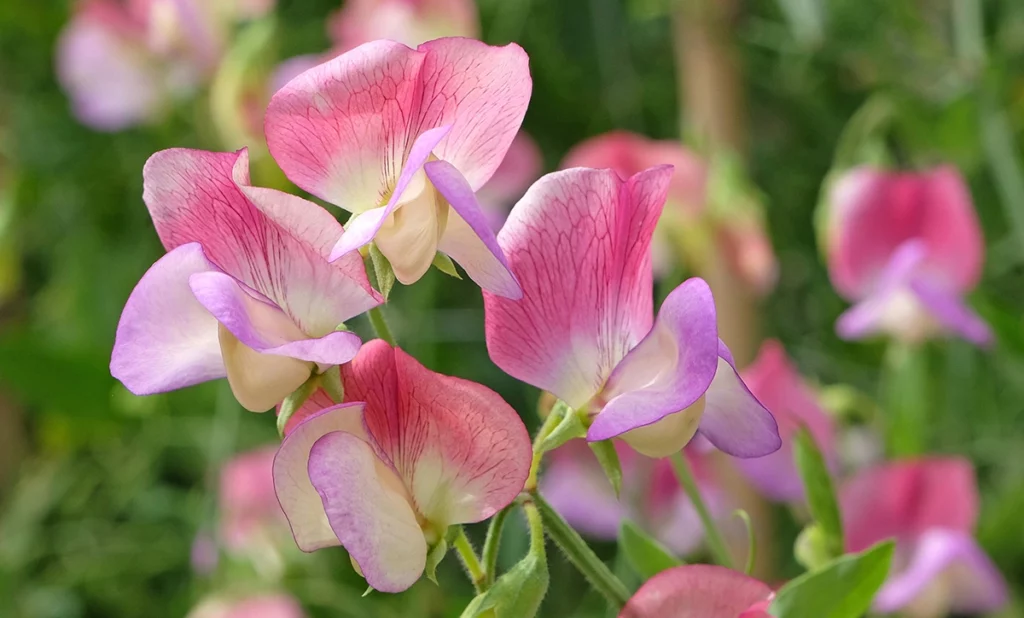
Passionflower
- Type: Perennial
- Size: 10–20 feet
- Hardiness Zones: 6–10
- Growing Conditions: Full sun to part shade, moist well-draining soil
- Bloom Season: Summer through early fall
- Care Tip: Prune in early spring to promote new growth and more flowers
Interesting Note: With its alien-like bloom structure, passionflower is a pollinator favorite. Some species even produce passionfruit, though only a few are edible. It’s also been used in herbal teas for its calming effects.
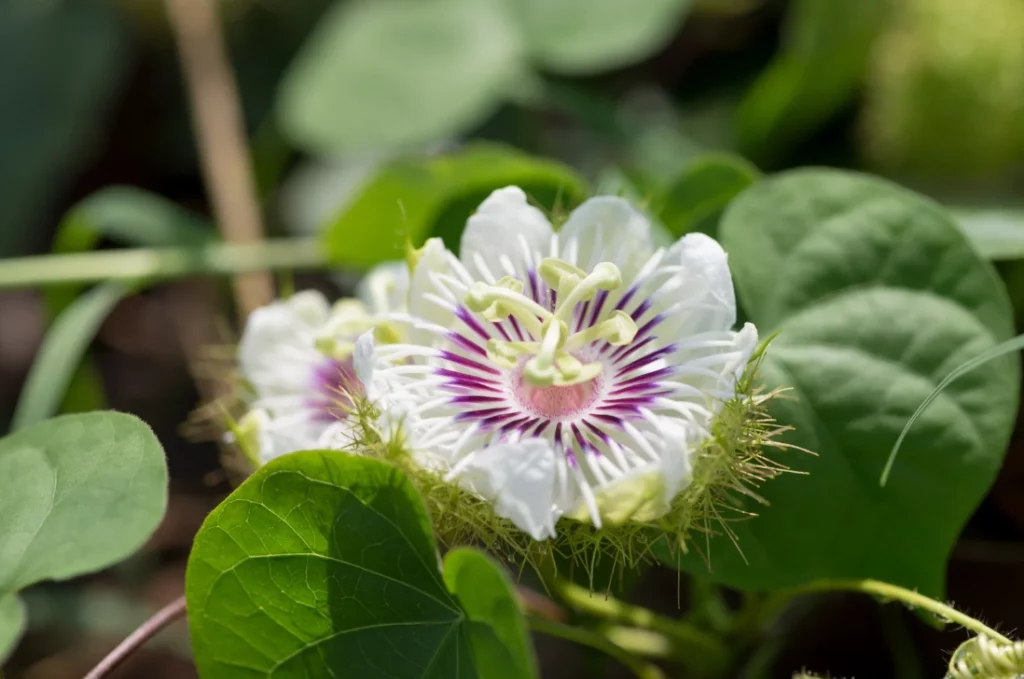
Bougainvillea
- Type: Perennial (evergreen in warm climates)
- Size: 10–40 feet
- Hardiness Zones: 9–11
- Growing Conditions: Full sun, well-drained sandy or rocky soil, low water needs
- Bloom Season: Spring through fall (nearly year-round in tropical areas)
- Care Tip: Keep water and fertilizer low to encourage more blooms rather than leafy growth
Interesting Note: The showy parts of bougainvillea are not petals. They’re modified leaves called bracts. True flowers are tiny and white, tucked inside the colorful display.
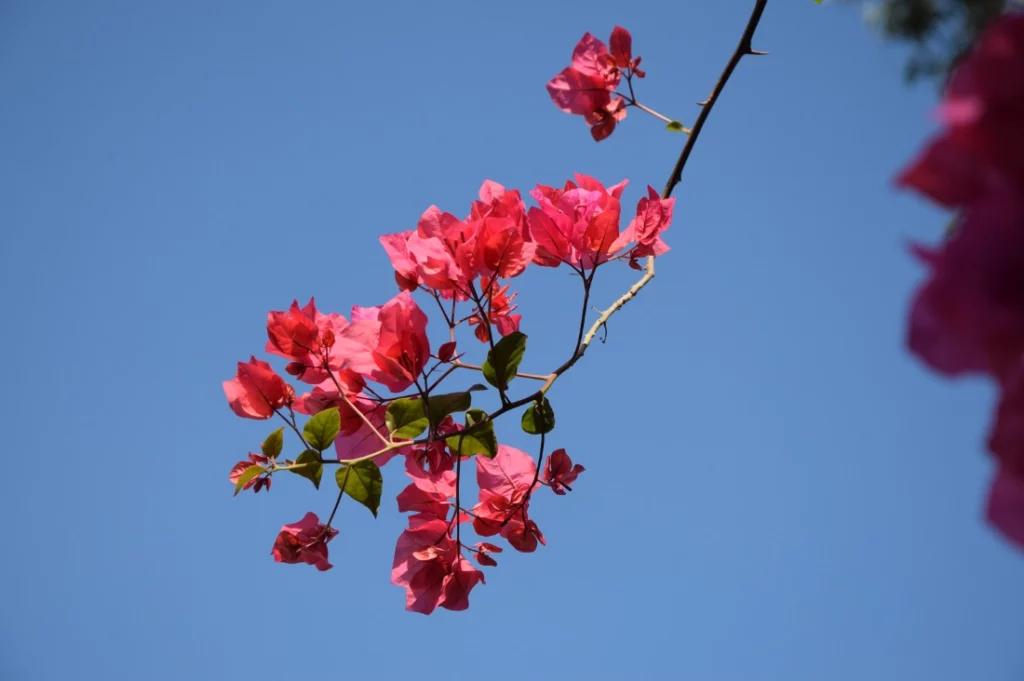
Black-Eyed Susan Vine
- Type: Annual (perennial in zones 10–11)
- Size: 5–8 feet
- Hardiness Zones: 3–11 (as annual)
- Growing Conditions: Full sun to light shade, moist well-drained soil
- Bloom Season: Late spring through frost
- Care Tip: Provide a lightweight trellis or allow it to trail from baskets or containers
Interesting Note: Not to be confused with the Black-Eyed Susan flower (Rudbeckia), this vine produces cheerful, five-petal blooms in orange, yellow, or white, often with a dark center.
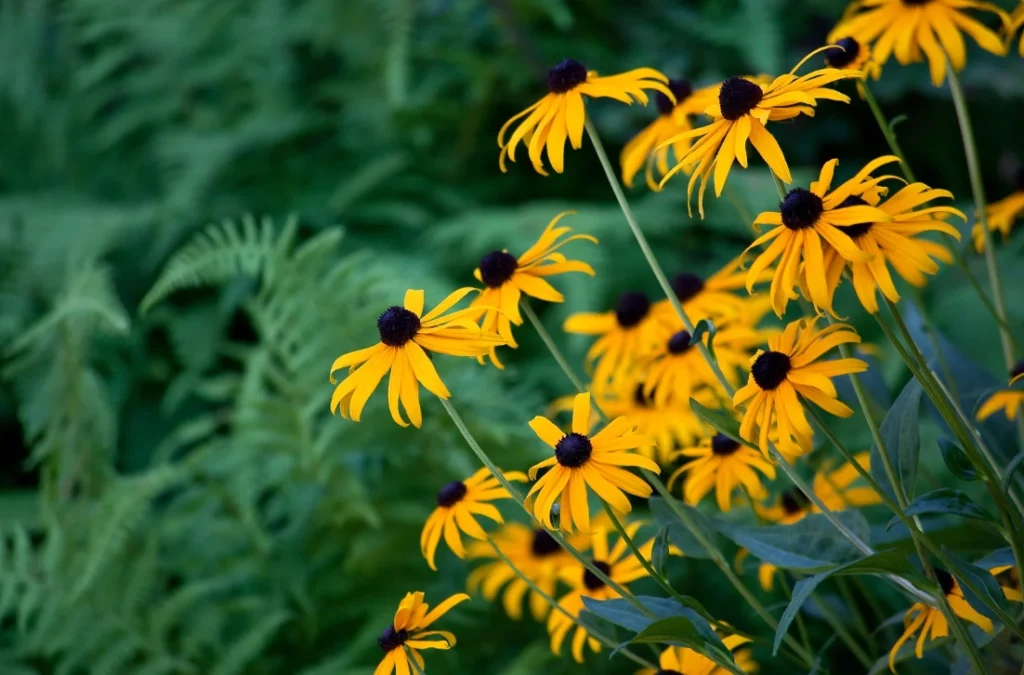
Honeysuckle
- Type: Perennial
- Size: 10–20 feet
- Hardiness Zones: 4–9
- Growing Conditions: Full sun to part shade, average well-drained soil
- Bloom Season: Late spring to midsummer (some rebloom later)
- Care Tip: Prune after flowering to shape the vine and keep it from becoming woody or invasive
Interesting Note: Honeysuckle flowers are rich in nectar and a favorite for hummingbirds and bees. Some varieties are fragrant, while others are grown purely for their color and climbing habit. Avoid overly aggressive types like Japanese honeysuckle in certain regions.
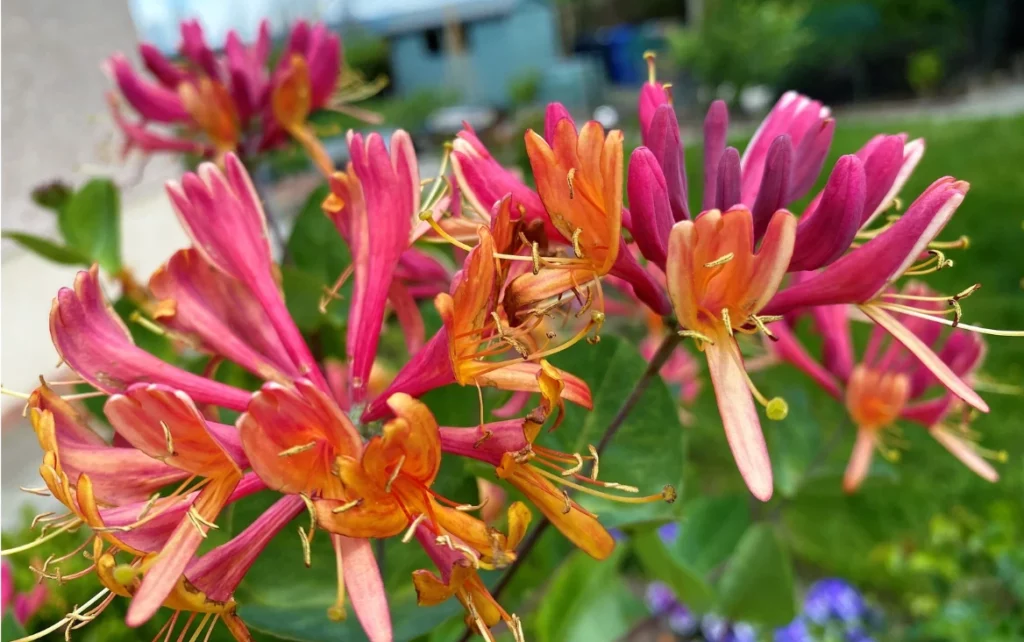
Climbing Roses
- Type: Perennial
- Size: 8–20 feet
- Hardiness Zones: 4–10
- Growing Conditions: Full sun, fertile well-draining soil, regular moisture
- Bloom Season: Spring to early summer, with repeat bloomers flowering through fall
- Care Tip: Tie long canes horizontally along supports to encourage more lateral blooming branches
Interesting Note: Unlike other vines, climbing roses don’t cling or twine. They need to be tied and trained. When properly supported, they create a stunning, romantic look on arches, fences, or walls.
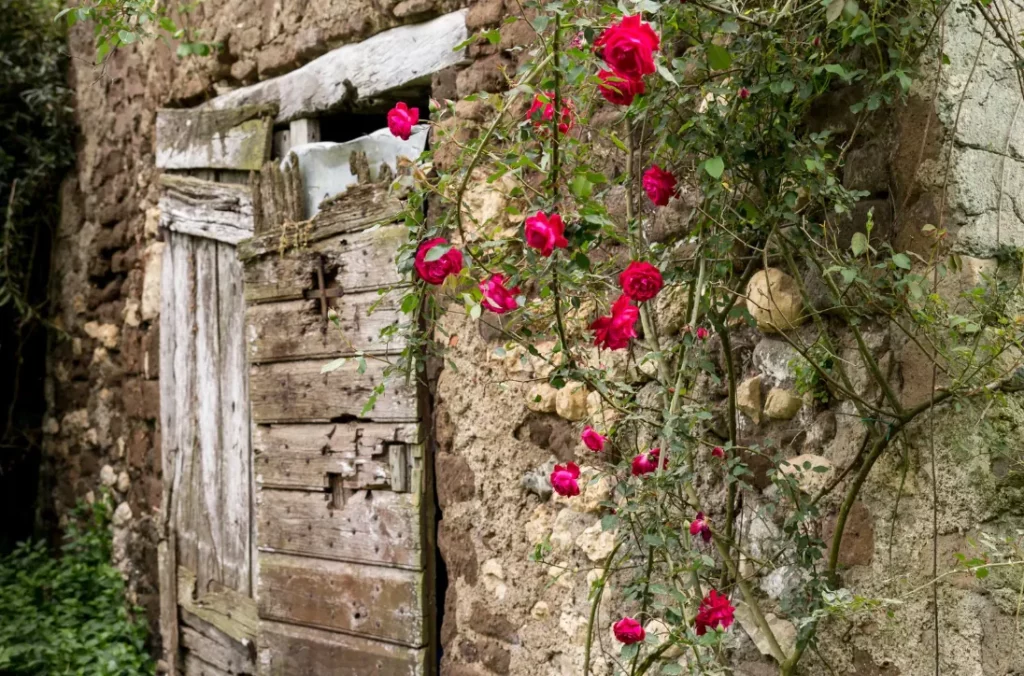
Mandevilla
- Type: Perennial (in warm zones), grown as annual in cooler zones
- Size: 10–15 feet
- Hardiness Zones: 9–11
- Growing Conditions: Full sun to part shade, moist but well-draining soil
- Bloom Season: Late spring through fall
- Care Tip: Feed regularly during the growing season to keep blooms coming
Interesting Note: Mandevilla thrives in containers and makes an excellent patio or balcony vine. Its trumpet-shaped flowers come in red, pink, or white and create a lush tropical vibe, especially when paired with ferns or palms.
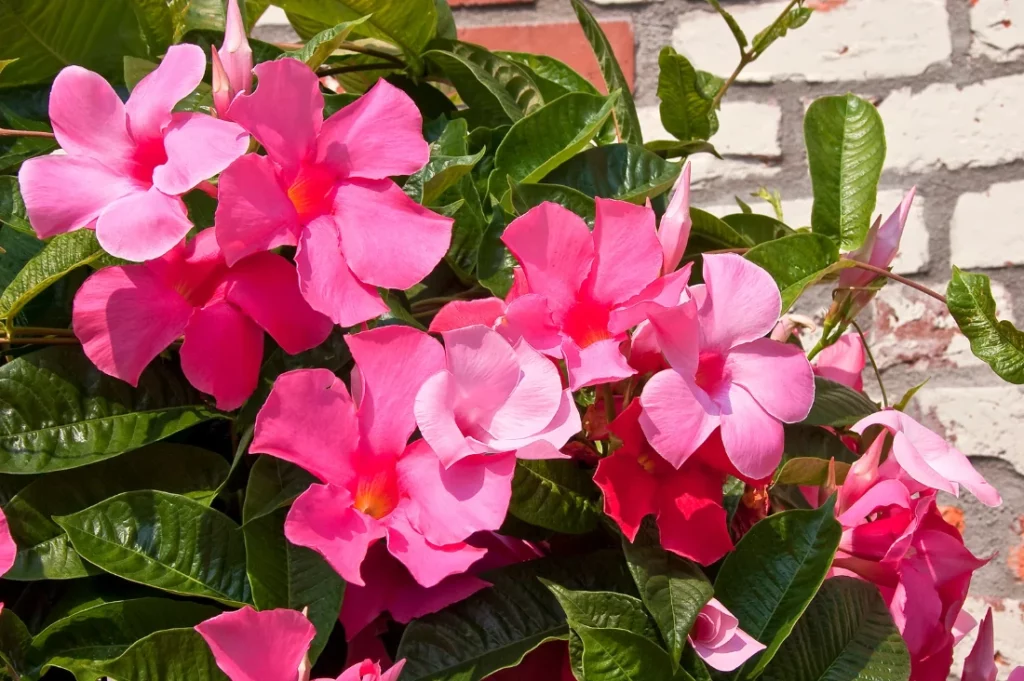
Climbing Hydrangea
- Type: Perennial
- Size: 30–50 feet
- Hardiness Zones: 4–8
- Growing Conditions: Part shade to full shade, moist rich soil, slow to establish but long-lived
- Bloom Season: Late spring to early summer
- Care Tip: Be patient. This vine can take a couple of years to really take off, but once it does, it needs little maintenance
Interesting Note: Unlike most vines, climbing hydrangea can cling directly to brick or stone using aerial rootlets. Its white lacecap blooms are fragrant and its bark peels beautifully in winter, offering year-round interest.

Coral Vine
- Type: Perennial (in warm zones), annual elsewhere
- Size: 20–40 feet
- Hardiness Zones: 8–11
- Growing Conditions: Full sun, well-drained soil, drought-tolerant once established
- Bloom Season: Summer through fall
- Care Tip: Water regularly during dry spells, especially in its first season
Interesting Note: Coral vine (also called “Queen’s Wreath”) produces chains of vivid pink flowers that are irresistible to bees and butterflies. It grows fast and can become invasive in tropical areas, so keep an eye on its spread.
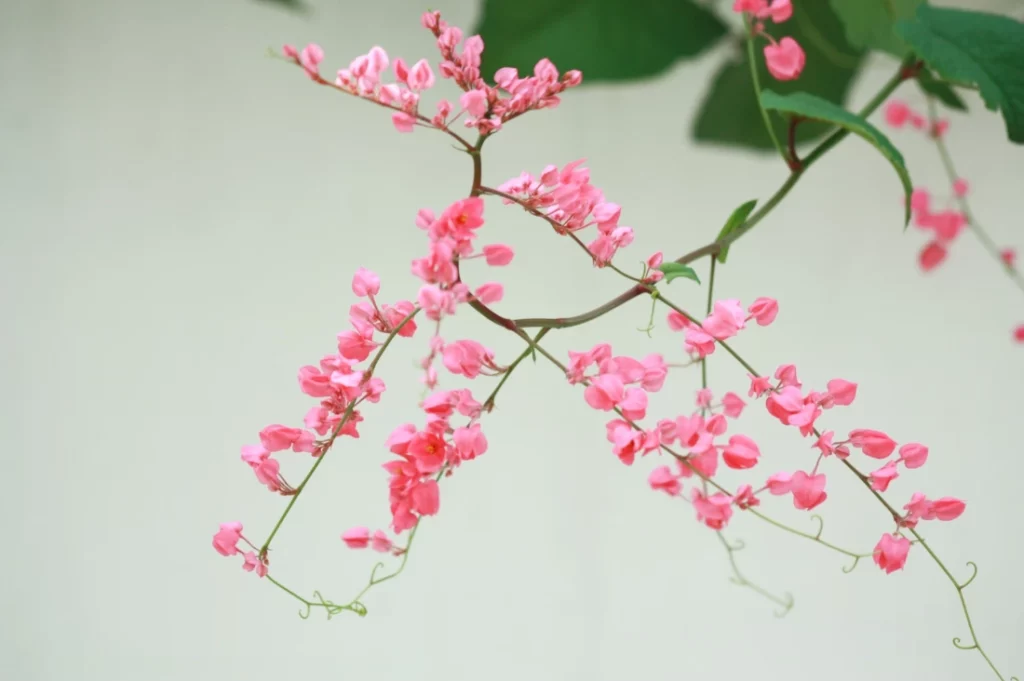
Dutchman’s Pipe
- Type: Perennial
- Size: 15–30 feet
- Hardiness Zones: 4–8
- Growing Conditions: Part shade to full sun, rich moist soil
- Bloom Season: Late spring to early summer
- Care Tip: Provide strong support and space so it grows dense and fast
Interesting Note: This vine gets its name from its unusual pipe-shaped flowers, which are more about curiosity than color. It’s often grown for its large, heart-shaped leaves that create a lush privacy screen. Bonus: it’s a host plant for the pipevine swallowtail butterfly.
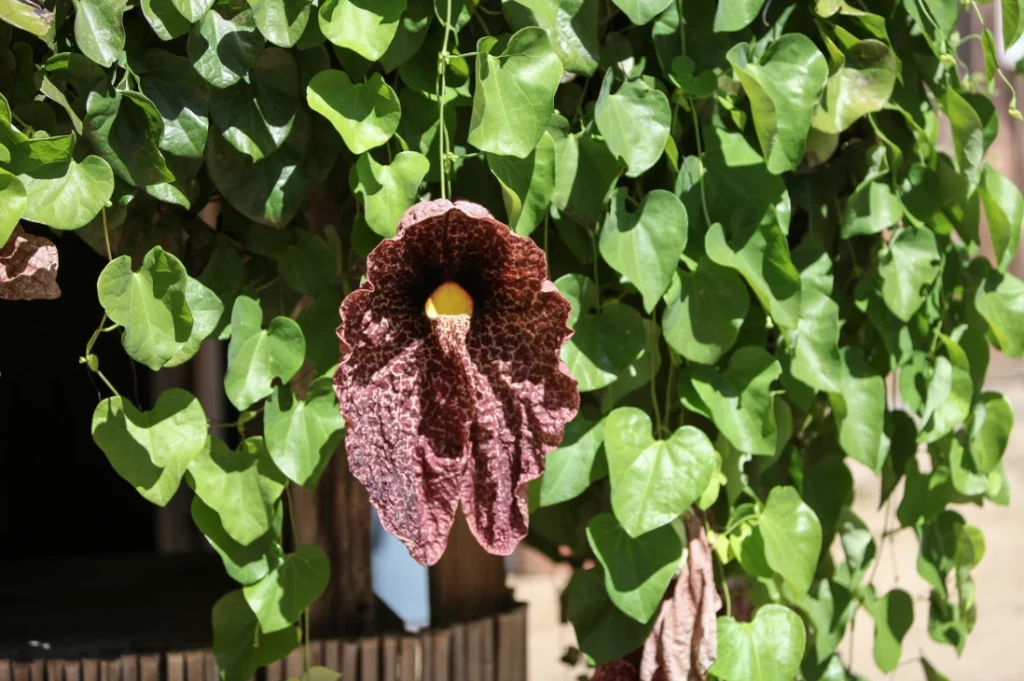
Star Jasmine
- Type: Perennial
- Size: 10–20 feet
- Hardiness Zones: 8–11
- Growing Conditions: Full sun to part shade, fertile well-drained soil
- Bloom Season: Late spring through summer
- Care Tip: Prune after blooming to control size and keep its shape
Interesting Note: Star jasmine fills the air with a sweet, gardenia-like fragrance when in bloom. It’s a favorite for patios, fences, and entryways. Even when not flowering, its glossy evergreen foliage adds beauty year-round in warm zones.
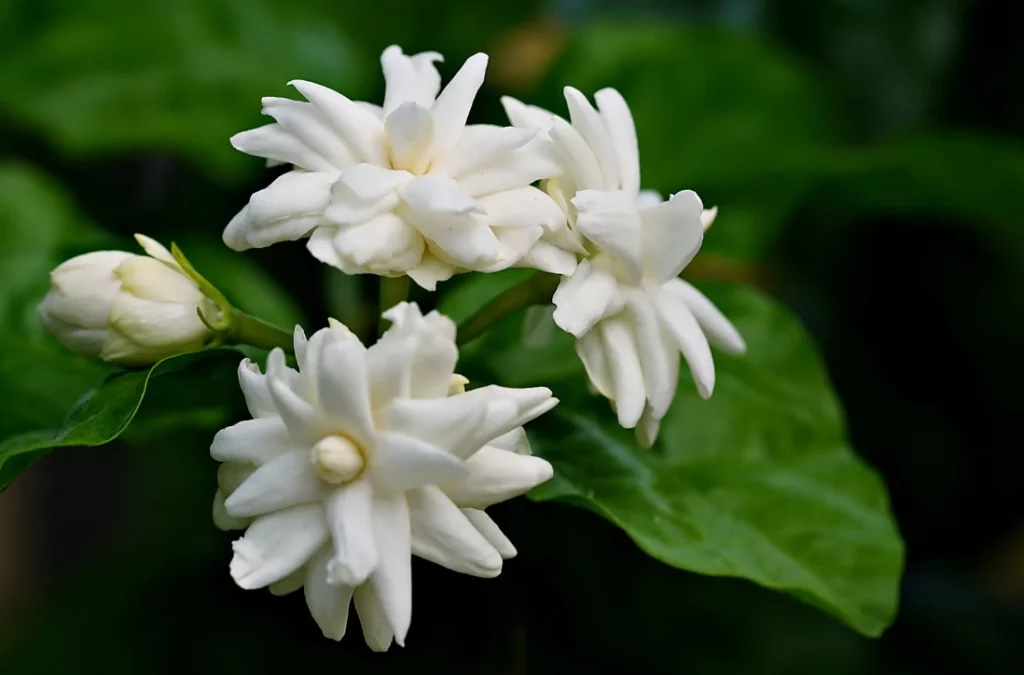
Purple Hyacinth Bean
- Type: Annual (can self-seed)
- Size: 10–15 feet
- Hardiness Zones: 3–11
- Growing Conditions: Full sun, rich well-drained soil, moderate water
- Bloom Season: Mid to late summer through fall
- Care Tip: Start from seed after frost; give it a trellis early, it grows fast
Interesting Note: This vine brings double appeal: pink-purple flowers followed by shiny deep purple seed pods. While the pods look edible, they must be cooked properly as some parts of the plant can be toxic if eaten raw.
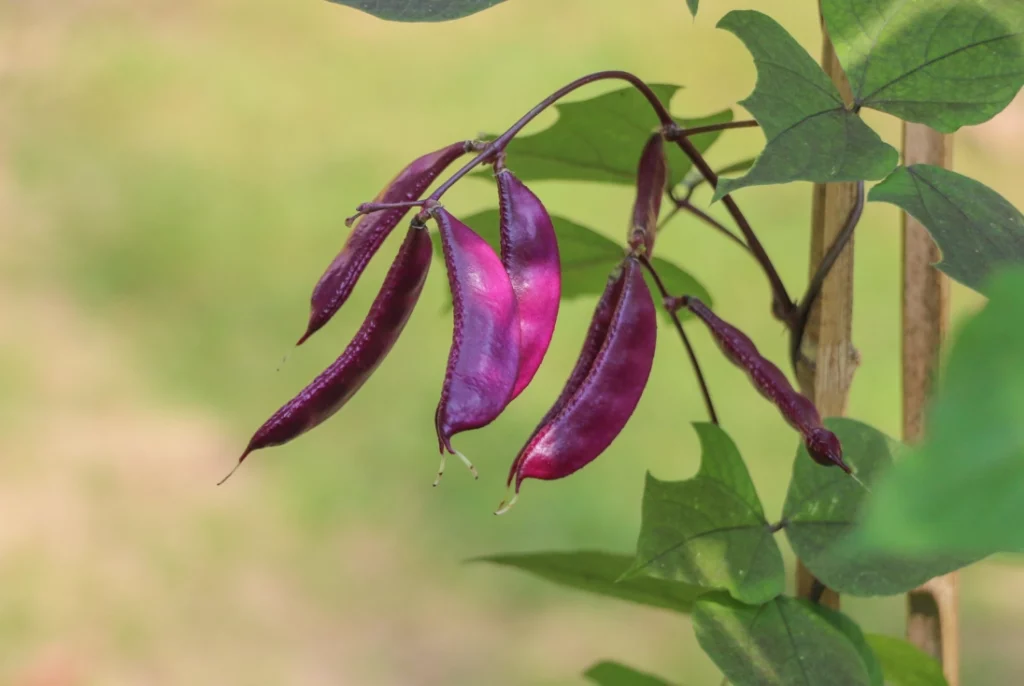
Canary Creeper
- Type: Annual
- Size: 6–12 feet
- Hardiness Zones: 2–11 (as annual)
- Growing Conditions: Full sun to part shade, light well-drained soil
- Bloom Season: Summer through fall
- Care Tip: Pinch tips to encourage branching and more blooms
Interesting Note: Related to nasturtiums, canary creeper has bright yellow flowers that resemble tiny birds in flight. It’s great for fences, window boxes, or letting trail from hanging baskets. Its foliage adds a delicate, lacy texture to the garden.
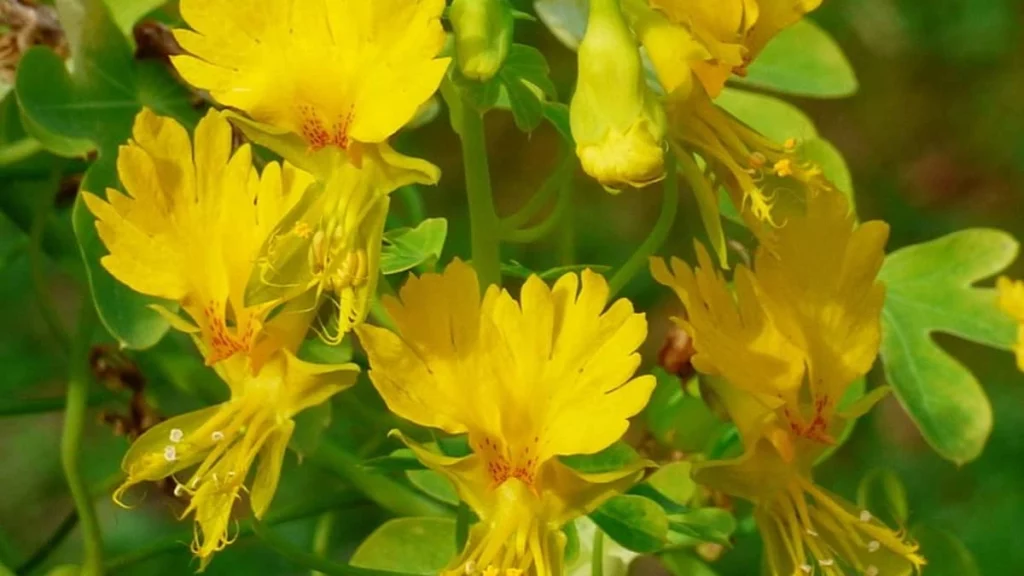
Conclusion
We’ve covered a wide range of flowering vines, each with its shape, size, and style. Some bloom quickly and fade, while others take their time but reward you with showy displays year after year. Knowing how each type grows makes it easier to plant and care for them. I hope you find this post helpful in planning your space or spotting vines in the wild. If you ever need help identifying a vine, open the Planteyes app and snap a quick photo.
FAQs
Why do vines grow on trees?
Vines grow on trees because they use them for support. Climbing helps vines reach sunlight without having to grow thick, self-supporting stems. This gives them an advantage in forests or shady gardens where light is limited. Some vines simply climb and coexist with the tree, while others can become invasive and harm it over time.
Can I grow flowering vines in pots?
Yes, many flowering vines thrive in containers, especially mandevilla, bougainvillea, and sweet peas. Ensure the pot is large enough and has good drainage. A support structure is also helpful.
How can I identify a flowering vine I don’t recognize?
You can use plant ID apps like Planteyes. Just take a clear photo of the vine’s leaves and flowers, and the app will give you an accurate result in seconds.
Why isn’t my flowering vine blooming?
Lack of flowers is often caused by too much shade, too much nitrogen, or pruning at the wrong time. Ensure your vine receives sufficient sunlight and avoid overfeeding it with high-nitrogen fertilizers.


